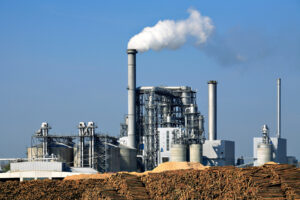Knight Materials
Thermal Destruction
A key component to any regenerative thermal oxidizer (RTO) is using proper heat transfer media to mitigate potential problems while ensuring reliable, economical and safe operation. Our structured and random media can resolve your RTO problems, like pressure drop, energy usage, alkali attack, particulate accumulation or a combination of issues.
Products
TER (Thermal Energy Recovery efficiency)
| 150 SCFM /ft2 | 200 SCFM /ft2 | 250 SCFM /ft2 | 300 SCFM /ft2 | 350 SCFM /ft2 | |
|---|---|---|---|---|---|
| FLEXERAMIC® 28 Structured Packing | 95.54% | 95.12% | 94.77% | 94.46% | 94.19% |
| 1" LPD® Random Packing | 93.46% | 92.86% | 92.35% | 91.91% | 91.53% |
| 1" FLEXISADDLE® Random Packing | 93.46% | 92.86% | 92.35% | 91.91% | 91.53% |
Pressure Drop (inches wc through inlet and outlet beds)
| 150 SCFM /ft2 | 200 SCFM /ft2 | 250 SCFM /ft2 | 300 SCFM /ft2 | 350 SCFM /ft2 | |
|---|---|---|---|---|---|
| FLEXERAMIC® 28 Structured Packing | 3.8" | 6.8" | 10.6" | 15.3" | 20.9" |
| 1" LPD® Random Packing | 4.7" | 8.3" | 13.0" | 18.8" | 25.7" |
| 1" FLEXISADDLE® Random Packing | 5.9" | 10.6" | 16.6" | 23.9" | 32.6" |
Conditions: based on two 8’ deep beds with 70°F inlet, 1500°F combustion, and 180 second switch time. Fuel is natural gas with 0% excess combustion air added.
Regenerative Thermal Oxidizers Markets and Applications
New types of industrial processing can challenge companies to comply with increasingly stringent emissions regulations. Those include industries that involve high gas flow rates, low VOC concentrations and intermittent or variable VOC emissions, such as those found in the printing, coating and chemical industries. Various equipment types can be employed to supply air pollution control. However, an RTO presents an effective solution for companies that need to control emissions from multiple process streams with different VOC compositions, as the system can handle a wide range of VOC concentrations and flow rates.
RTOs are a widely used technology for air pollution control, particularly for industrial applications that emit volatile organic compounds (VOCs). The market for RTOs is estimated to grow through 2027 in response to rapid industrialization and the need to comply with the regulatory policies of individual countries or municipalities.

Typical industries that utilize RTOs to comply with emissions regulations include:
- Printing and packaging. These use a variety of solvents and inks that emit VOCs.
- Chemical manufacturing. This industry might be most closely associated with VOCs, encompassing many products and processes, such as plastics, rubber, cleansing agents or adhesives.
- Automotive. Painting and coating operations associated with automotive manufacturing contribute to VOC emissions.
- Semiconductor manufacturing. Semiconductor fabs utilize a wide range of solvents and chemicals during manufacturing.
- Pulp and paper. Manufacturing many different types of wood products includes chemicals that can omit VOCs.
- Pharmaceuticals. Depending on the end product, processing may involve solvents or other chemicals that emit VOCs.
Emerging industries and growing VOC emissions
In the last ten years, emerging or growing industries can be added to the list of applications requiring an RTO for emissions control. As each industry grows and processing facilities increase in size or production capacity, an RTO can capture the VOC emissions and pollutants.
Multiple benefits associated with the right RTO installation include greater RTO energy efficiency and energy savings, enabling compliance with local and federal emissions regulations, and further, promoting brand image associated with a company’s sustainability efforts related to environmental issues.
Installation of an RTO to capture pollutants for the betterment of the environment could be considered eco-innovation. The phrase refers to any corporate effort to foster sustainability and green business practices. Companies that invest in eco-innovation efforts typically experience better growth rates than companies that do not, according to one market research study.
A few up-and-coming industries that must deal with VOCs can include:
- Additive manufacturing. Additive manufacturing or 3D printing processes is growing an average of 30% per year. Processes associated with this manufacturing technology can emit VOCs, particulate matter or other pollutants related to the materials and solvents used during the additive printing process. These can vary depending on the type of process used. Total VOC emission rates were higher from stereolithography (SLA) 3D printing than fused filament fabrication (FFF).
- Cannabis. The cannabis industry provides another example of a relatively new industry that may require an RTO for emissions control. Cannabis cultivation and processing can involve using solvents such as butane, propane and ethanol for extraction, which can emit VOCs and other pollutants into the environment. This industry is currently governed on a state-by-state basis. Individual states and some local municipalities have enacted emissions regulations that might require control technologies with a high VOC destruction efficiency. This industry has a projected CAGR of 26.2% through 2030, with an anticipated market size for legalized cannabis of 135 billion.
- Biomass energy conversion. Another industry of note is biomass conversion for energy or other purposes. Biomass pellet plants, for example, can emit formaldehyde, a hazardous air pollutant. Larger pellet plants are prescribed RTOs to control VOC emissions emanating from wood dryers. The global biomass power market alone has a CAGR of 5.73% through 2030.
Geometrically arranged corrugated blocks such as FLEXERAMIC® structured packing media from Knight provide greater fouling resistance. This highly engineered design can shave height off the RTO tower to cut initial construction costs and ongoing maintenance. The system design supplies high capacity, greater RTO energy efficiency and lower pressure drop compared to random ceramic packing.
Frequently Asked Questions
The media used in a regenerative thermal oxidizer (RTO) consists of various ceramic packing materials or structured components which are placed inside the tower or chamber along with other engineered internal components. The selected RTO media creates a large surface area for heat exchange and pollutant absorption during the treatment of industrial exhaust gases. Proper media selection and placement promote efficient heat recovery and pollutant removal, which enables companies to meet emissions requirements.
The types of media used in a regenerative thermal oxidizer (RTO) typically include ceramic saddles, structured packing or other random packing materials. These media are used in the RTO bed to create a large surface area for heat exchange and pollutant removal during the treatment of industrial exhaust gases.
In the context of a regenerative thermal oxidizer (RTO), the media for heat transfer typically refers to the packing materials used within the RTO tower. These materials, such as random ceramic saddles or structured packing, are strategically arranged to facilitate efficient heat exchange between hot and cold gas streams. This serves the twin purpose of helping to preheat incoming pollutants while also reducing energy consumption during the oxidation process.
The choice of the best heat transfer medium for regenerative thermal oxidizers (RTOs) depends on various factors such as operating temperature, specific application requirements and efficiency goals. The selection often involves consideration of materials such as ceramic saddles or structured packing. These both serve to optimize heat exchange and thermal efficiency within the RTO system. However, structured packing has an advantage by requiring fewer re-packs, lower pressure drop and less fouling.
The thermal efficiency of RTOs often exceeds 95%. This number can vary depending on factors such as design, operating conditions, and the specific application.
RTOs achieve this high efficiency by utilizing a regenerative heat exchange process, preheating the incoming polluted airstream by transferring heat from the hot, outgoing airstream through a ceramic media bed. This heat exchange minimizes the energy required to maintain the necessary operating temperature for the oxidation of volatile organic compounds (VOCs) or other pollutants in the exhaust gas.
When properly designed, operated, and maintained RTO systems can offer excellent energy efficiency while effectively reducing air pollution.
The destruction efficiency of a thermal oxidizer is its ability to effectively destroy or convert harmful pollutants in the exhaust gas stream into harmless byproducts such as water vapor and carbon dioxide.
The destruction efficiency can vary depending on several factors, including:
- Operating temperature: Higher temperatures generally lead to higher destruction efficiencies, as they facilitate more complete combustion of the pollutants.
- Presence of catalysts: Some thermal oxidizers use catalysts to enhance the oxidation reactions, which can increase destruction efficiency.
- Type and concentration of pollutants: Different pollutants may require different temperatures and conditions for effective destruction.
- Packing functionality: The right structured packing for RTOs can allow proper heating and gas flow with minimal pressure drop.
- RTO design: The right design and optimization will impact energy efficiency as well as assist in meeting regulatory requirements and environmental standards.
- Type of packing material: Different packing material within the RTO design can affect flow, pressure drop and heat transfer.
Thermal destruction refers to the process of breaking down or destroying a substance by applying heat. When a material is subjected to high temperatures, its molecular structure can be altered, leading to chemical reactions that change its composition or physical properties. This concept is commonly encountered in fields such as chemistry, physics, and engineering, where controlled heating or thermal processing is used to achieve specific outcomes like sterilization, decomposition, or synthesis of new compounds.
In the context of Regenerative Thermal Oxidizers (RTOs), thermal destruction refers to the process by which volatile organic compounds (VOCs) and hazardous air pollutants (HAPs) are eliminated or “destroyed” through high-temperature oxidation.
The temperature of the exhaust from a Regenerative Thermal Oxidizer (RTO) can vary depending on several factors, including the design of the RTO, the type of pollutants being treated and the operating conditions. However, the exhaust temperature typically ranges from 250°C to 350°C (482°F to 662°F) after the oxidation process.
During the operation of an RTO, the incoming polluted air is heated to a high temperature (usually between 1400°F to 1600°F or 750°C to 870°C) in the combustion chamber to facilitate the oxidation of volatile organic compounds (VOCs) and hazardous air pollutants (HAPs).
The specific temperature of the exhaust can also be influenced by factors such as the efficiency of heat recovery systems, the flow rate of the exhaust gases and any additional cooling or post-treatment processes implemented downstream of the RTO.
FLEXERAMIC, as a structured packing material, can influence the temperature of the RTO exhaust in several ways:
- Heat transfer efficiency
- Extended residence time
- Uniform gas distribution
- Lower pressure drop

